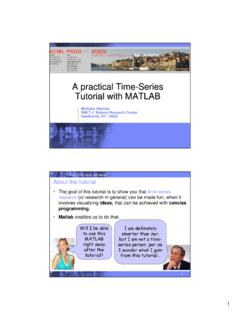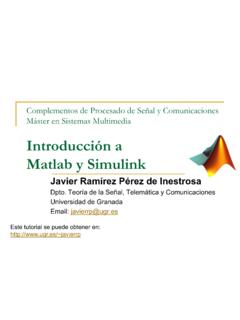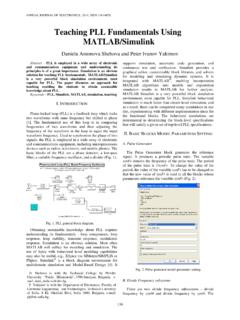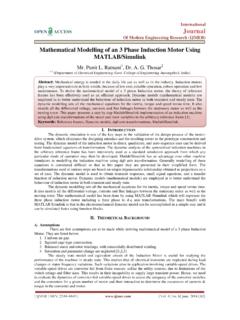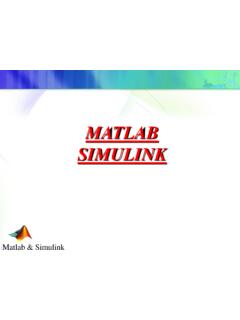Transcription of Matlab and Simulink for Modeling and Control - …
1 Matlab and Simulink for Modeling and ControlRobert Babu ska and Stefano StramigioliNovember 1999 Delft University of TechnologyDelftControl LaboratoryFaculty of Information Technology and SystemsDelft University of Box 5031, 2600 GA Delft, The Netherlands1 IntroductionWith the help of two examples, a DC motor and a magnetic levitation system, the use of MATLABandSimulink for Modeling , analysis and Control design is demonstrated. It is assumed that the reader alreadyhas basic knowledge of MATLABand Simulink . The main focus is on the use of the Control System Toolboxfunctions. We recommend the reader to try the commands out directly in Matlab while reading this text. Theexamples have been implemented by the authors and can be downloaded implementation is done in Matlab version and has also been tested in version Modeling a DC MotorIn this example we will learn how to develop a linear model for a DC motor, how to analyze the model underMATLAB (poles and zeros, frequency response, time-domain response, etc.)
2 , how to design a controller, andhow to simulate the open-loop and closed-loop systems under Physical SystemConsider a DC motor, whose electric circuit of the armature and the free body diagram of the rotor are shownin Figure +Vb= K b -+-Figure 1: Schematic representation of the considered DC rotor and the shaft are assumed to be rigid. Consider the following values for the physical parameters:moment of inertia of the rotorJ= kg m2damping (friction) of the mechanical systemb= Nms(back-)electromotive force constantK= Nm/Aelectric resistanceR=1 electric inductanceL= HTheinputis the armature voltageVin Volts (driven by a voltage source). Measured variables are the angularvelocity of the shaft!in radians per second, and the shaft angle in System EquationsThe motor torque,T, is related to the armature current,i, by a constant factorK:T=Ki:(1)The back electromotive force (emf),Vb, is related to the angular velocity by:Vb=K!
3 =Kd dt:(2)1 From Figure 1 we can write the following equations based on the Newton s law combined with the Kirchhoff slaw:Jd2 dt2+bd dt=Ki;(3)Ldidt+Ri=V Kd dt:(4) Transfer FunctionUsing the Laplace transform, equations (3) and (4) can be written as:Js2 (s)+bs (s)=KI(s);(5)LsI(s)+RI(s)=V(s) Ks (s);(6)wheresdenotes the Laplace operator. From (6) we can expressI(s):I(s)=V(s) Ks (s)R+Ls;(7)and substitute it in (5) to obtain:Js2 (s)+bs (s)=KV(s) Ks (s)R+Ls:(8)This equation for the DC motor is shown in the block diagram in Figure ()LoadBack emfVoltageAnglew( )sVs()+-1Js+bq( )sKVsb()KLs+R1sFigure 2: A block diagram of the DC equation (8), the transfer function from the input voltage,V(s), to the output angle, , directly follows:Ga(s)= (s)V(s)=Ks[(R+Ls)(Js+b)+K2]:(9)From the block diagram in Figure 2, it is easy to see that the transfer function from the input voltage,V(s),tothe angular velocity,!
4 ,is:Gv(s)=!(s)V(s)=K(R+Ls)(Js+b)+K2:(10) 3 Matlab RepresentationThe above transfer function can be entered into Matlab by defining the numerator and denominator polyno-mials, using the conventions of the Matlab s Control Toolbox. The coefficients of a polynomial insare2entered in a descending order of the powers :The polynomialA=3s3+2s+10is in Matlab entered as:A=[30210].Furthermore, we will make use of the functionconv(A,B), which computes the product (convolution) of thepolynomialsAandB. Open the It already contains the definition of the motor constants:J= ;b= ;K= ;R=1;L= ;The transfer function (9) can be entered in MATLABin a number of different AsGa(s)can be expressed asGv(s) 1s, we can enter these two transfer functions separately andcombine them in series:aux = tf(K,conv([L R],[J b]))Gv = feedback(aux,K);Ga = tf(1,[1 0])*Gv;Here, we made use of the functionfeedbackto create a feedback connection of two transfer functionsand the multiplication operator*,whichisoverloadedby the LTI class of theControl System Toolboxsuch that is computes the product of two transfer Instead of using convolution, the first of the above three commands can be replaced by the product oftwo transfer functions:aux = tf(K,[L R])*tf(1,[J b]);3.
5 Another possibility (perhaps the most convenient one) is to define the transfer function in a symbolicway. First introduce a system representing the Laplace operators(differentiator) and then enter thetransfer function as an algebraic expression:s = tf([1 0],1);Gv = K/((L*s + R)*(J*s + b) + K 2);Ga = Gv/s;It is convenient to label the inputs and outputs by the names of the physical variables they = Voltage ; = Velocity ; = Voltage ; = Angle ;Now by callingmotorfrom the workspace, we have both the velocity (Gv) and the position (Ga) transferfunctions defined in the Exercises1. ConvertGvandGainto their respective state-space (functionss) and zero-pole-gain (functionzpk) What are the poles and zeros of the system? Is the system stable? Why?3. How can you use MATLABto find out whether the system is observable and controllable?34 AnalysisTheControl System Toolboxoffers a variety of functions that allow us to examine the system s Time-Domain and Frequency ResponsesAs we may want plot the responses for the velocity and angle in one figure, it convenient to group the twotransfer functions into a single system with one input, the voltage, and two outputs, the velocity and the angle:G = [Gv; Ga];Another way is to first convertGainto its state-space representation and then add one extra output being equalto the second state (the velocity):G = ss(Ga);set(G, c ,[0 1 0; 0 0 1], d ,[0;0], OutputName ,{ Velocity ; Angle });Note that this extension of the state-space model with an extra output has to be done in onesetcommand inorder to keep the dimensions , we can plot the step, impulse and frequency responses of the motor model:figure(1); step(G);figure(2); impulse(G);figure(3); bode(G).
6 You should get the plots given in Figure 3 and Figure (sec.)AmplitudeStep : VoltageTo: To: AngleTime (sec.)AmplitudeImpulse : VoltageTo: To: AngleFigure 3: Step and impulse Exercise1. Simulate and plot in MATLABthe time response of the velocity and of the angle for an input signalcos 2 t,wheretgoes from 0 to 5 (rad/sec)Phase (deg); Magnitude (dB)Bode Diagrams 100 500 From: Voltage 200 1000 To: Velocity 2000200 10 210 1100101102 400 2000 To: AngleFigure 4: Bode Control DesignLet us design a PID feedback controller to Control the velocity of the DC motor. Recall that the transferfunction of a PID controller is:C(s)=U(s)E(s)=Kp+Kis+Kds=Kds2+Kps+Kis ;(11)whereuis the controller output (in our case the voltageV),e=uc yis the controller input (the controlerror), andKp,Kd,Kiare the proportional, derivative and integral gains, respectively. A block diagram ofthe closed-loop system is given in Figure MotorVelocityVVoltage e+ PIDF igure 5: Closed-loop system with a PID Proportional ControlFirst, try a simple proportional controller with some estimated gain, say, 100.
7 To compute the closed-looptransfer function, use thefeedbackcommand. Add the following lines to your m-file:Kp = 100;Gc = feedback(Gv*Kp,1); = Desired velocity ;5 HereGcis the closed-loop transfer function. To see the step response of the closed-loop system, enter:figure(4); step(Gc,0 :2);You should get the plot given in Figure 6:Time (sec.)AmplitudeStep : Desired velocityTo: VelocityFigure 6: Closed-loop step response with a P eliminate the steady-state error, an integral action must be used. To reduce the overshoot, a derivativeaction can be employed. In the following section, a complete PID controller is PID ControlLet us try a PID controller. Edit your M-file so that it contains the following commands:Kp = 1;Ki = ;Kd = ;C = tf([Kd Kp Ki],[1 0]);rlocus(Ga*C);Kp = rlocfind(Ga*C);Gc = feedback(Ga*C*Kp,1);figure(9); step(Gc,0 :5)Therlocusandrlocfindfunctions are used to select the overall gain of the PID controller, such that the con-troller is stable and has the desired location of the poles (within the defined ratio among theKp,KiandKdconstants).
8 If the design is not satisfactory, this ratio can be changed, of course. We should obtain a plotsimilar to the one in Figure 7 Exercise1. Use the root locus and the Nyquist criterion to find out for what value of the gainKpthe proportionalcontroller for the angleGa(s)becomes (sec.)AmplitudeStep To: AngleFigure 7: Closed-loop step response with a PID Simulink ModelThe block diagram from Figure 2 can be directly implemented in Simulink , as shown in the figure Figure 8:omegaTo WorkspacetTo Workspace Clockangularspeeds1 Step InputLs+RK(s)ArmatureJs+b1 Load+ KthetaTo Workspace angleFigure 8: Simulink block diagram of the DC the simulation parameters and run the simulation to see the step response. Compare with the response inFigure 3. Save the file under a new name and remove the position integrator along with the Graph and ToWorkspace blocks. Group the block describing the DC motor into a single block and add a PID controlleraccording to Figure 5.
9 The corresponding Simulink diagram is given in Figure 9. Experiment with thecontroller. Compare the responses with those obtained previously in Obtaining Matlab Representation from a Simulink ModelFrom a Simulink diagram, a Matlab representation (state space, transfer function, etc.) can be Inport and Outport blocks must be added to the Simulink diagram, as shown in Figure we can use thelinmodcommand to obtain a state-space representation of the diagram:[A,B,C,D] = linmod( filename );wherefilenameis the name of the Simulink motoromegaTo WorkspaceangularspeedStep Input+ SumPIDC locktTo Workspace Figure 9: Simulink block diagram of the DC motor with a PID +RK(s)ArmatureJs+b1 Load+ K1 Outport1 InportFigure 10: Simulink block diagram of the DC motor with Inport and Outport Exercise1. Convert the four matricesA,BCandDinto a corresponding state space LTI object.
10 Convert this oneinto a transfer function and compare the result with the transfer function entered previously in Linearization of Nonlinear Simulink ModelIn this section, we will use an example of a highly nonlinear system to show how to linearize a nonlinearSimulink model and extract the linearized model to MATLABfor Control design Magnetic Levitation SystemMagnetic levitation as a friction-less support for high-speed trains, in bearings of low-energy motors, etc. Itconsists of an electromagnet which is attracted to an object made of a magnetic material (such as a rail). Thecontrol goal is to keep the air gap between this material and the electromagnet constant by controlling thecurrent in the coil. A schematic drawing is given in Figure 11:Schematic drawing of the magnetic levitation position and the motion of the object in the magnetic field are dependent on the forces that act on forces are:(i)the gravitational force,(ii)the electromagnetic force, and(iii)a disturbance force.


